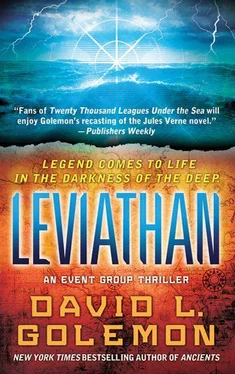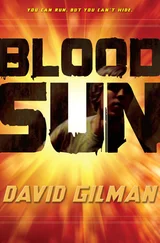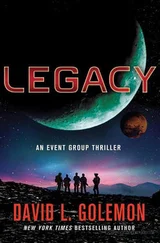"The analysis on the battery casings."
"You mean the rubber?"
"Yes," Ellenshaw said as his gaze wandered the interior of the vault, not settling on any one spot.
The cryptozoologist walked over to the lump of burned rubber and ran his slim fingers over its rough surface.
"Several tons of raw rubber would have been used in the research and construction of the many, many batteries enclosed in the vessel. I'm sure of it, it's so obvious," he said as he finally looked down at his assistant. "Traceable rubber." He smiled for the first time.
"I don't think you can trace rubber, Professor," she said.
"Not the rubber, Miss Birdsong — the research and development, and the plantations that produced it."
"You think you can trace the research and plantations back that far?"
"One thing you can always count on is the fact that companies and universities the world over require data — progress reports for the expenditure of funds — and those reports have to be filed."
"But it's been so long—"
Ellenshaw didn't hear her words as he shot out of the vault and disappeared.
* * *
The meeting inside the main conference room on level seven began on time.
"Before we get started, I just overheard several conversations about the kidnapping of our personnel. This has to stop. It may sound cold to many of you, but that train of thinking will just get in our way. It will make you try too hard, press, and believe me, you'll screw up. Now, let's get started."
Pete nodded toward Will Mendenhall, who turned and opened the door for three women to enter the conference room. They were carrying two large plastic containers. They placed these on the conference table.
"This is Professor Angela Vargas, of the physics and nuclear sciences department. She's heading things up in Virginia's absence," Pete explained.
As the young physicist pulled material from the first box, Jack noticed for the first time that Charles Hindershot Ellenshaw III was not present; he never made it back from the burned-out vault area. In addition, Dr. Gene Robbins was missing from the meeting. Collins hoped both men were getting somewhere with their individual assignments.
"This is one of the protective jumpsuits the attackers were wearing, recovered from one of the bodies — the one killed by Lieutenant McIntire," Vargas said as she looked at her notes.
Everett chanced a look over at Jack, but he sat stoically and did not react at all to Sarah's name or her killing of one of the assailants.
"At first glance, we thought it was a standard special forces-issued garment, until we placed it under the electron microscope per Dr. Golding's orders to leave no stone unturned. Well, he was right." She handed the black jumpsuit to Jack. He didn't react to the dried blood. "Colonel, feel the material. What would your opinion be?"
"It feels like standard issue, maybe with some Kevlar weaved in, what we would call Nomex IIIA."
"Very good, Colonel, however you are wrong. Not Nomex, not polyester, not a Kevlar weave." She looked around the room for dramatic effect. "It's seaweed."
The department heads mumbled as they looked at the material.
"That's right, Callophycus serratus , very rare, very expensive. This seaweed has also been known to kill cancer cells. Therefore, if someone has such an abundance of this seaweed to make clothing, they must have a rich farm of unknown size in the ocean depths."
"Where is this seaweed found, Professor?" Jack asked as he and many others were busy scribbling on the pads.
"Two of the only known sites in the world are located just off of Fiji, and the largest is off Papua, New Guinea. The rest of the seaweed beds in the world wouldn't be enough to make a string bikini, much less outfit a bunch of pirates."
"Very good, nice start, Professor. What else have you got?" Pete asked.
"This." She brought out one of the strange-looking weapons. It was short, powerful looking, and jet-black.
Carl Everett sat up and looked at the weapon Professor Vargas was holding so cavalierly. When she suddenly tossed the weapon at him, he caught it with both hands. Then his eyebrows rose and he stood away from the table. The entire weapon, with ammunition magazine, could not have weighed more than three pounds.
"It's light, too light to be real," Carl said as he handed the weapon to Jack.
"There's a reason for that, Captain. It's not made of steel. Believe me when I say no gunsmith in the world has ever seen anything like that weapon. I fired it myself at the shooting range. It's compact and extremely accurate."
"Okay, you've amazed us, Professor. What's it made of?"
"All we know is that it is some kind of polymer. Plastic, but unlike any plastic we have ever seen before. It will take months to break the matrix down so we can analyze it. However, a new plastic is not what's so amazing about this weapon — it's the characteristics of the material. For the first time in history, someone has invented a biodegradable plastic that will disintegrate, with only natural forces working against it, in fifteen to twenty years of being buried in soil."
"Impossible," several men and women said at the same time.
"Our environmental chamber experiments are documented and are available, and confirmed through Europa. It's there, read the report. We don't know who we're dealing with here, but whoever they are, they're far more than a century ahead of us in technology."
The room grew quiet as everyone absorbed what the professor had said. Their hopes of finding and stopping this group were growing fainter.
Carl looked over at Jack and stood.
"I'm getting back to work. Dr. Robbins needs supervision."
Collins nodded as Everett left the conference room.
"Thank you, Professor. Please inform me when you have conducted tests on all material recovered from our intruders." Pete rubbed his forehead and tried to think, but he was just too tired. He removed his thick glasses and looked at all the department heads.
"You have your assignments in front of you. Some departments will be coordinating with others that seemingly have no business being put together. We are shorthanded and have been for the past six weeks. The next few days won't be any different. We're calling in former members to assist in filling vacancies, but that will take a while. Thank you, we'll meet again when we—"
At that moment, the doors opened and in came Ellenshaw. He held up a sheath of papers and several computer discs. He nodded at Pete, indicating he had news.
Pete nodded to Ellenshaw, who in turn gave several discs to the audiovisual technician who dimmed the lights and turned on the main holographic machine. The hologram projector used a micromisting system in the ceiling to create the 3-D effect without the need for a screen, and the four projectors hit the water mist from four sides, producing the hologram effect.
"Okay, what we have here is a visual of vault 298907, placed inactive for further investigation on nine October nineteen eighty-three. This is file footage of the vault before the fire. We do have detailed pictures and listings of everything documented on that submarine. Dr. Golding assigned me the task of digging through the mess inside the vault, while the engineers were busy shoring up the affected levels. I have a rather bizarre and fantastic theory I would like to advance, which I am accustomed to doing, about the submarine and its origins."
The man with wild white hair looked around the table. His lab coat was dirty and water-stained from the flooded vault, and one of his pant legs was still rolled up past his right ankle. He smiled and raised his half-moon glasses into his crazily swirling hair.
"As you may know, we have had many discussions in the past about this strange vessel and its origins. Being as old as it is, let us say it's made for some very far-out speculation in crypto, I'll tell you. Number one among most theories, and it's common knowledge I support said theory, is that Jules Verne may have received inspiration for his novel, Twenty Thousand Leagues Under the Sea , from this very artifact. The chances are just too farfetched not to connect the dots here. However, that is not of importance at this time. What is of paramount importance is why this modern-day crackpot wants to destroy something that is at least a hundred and fifty years of age and seemingly could cause them no harm at all?"
Читать дальше












